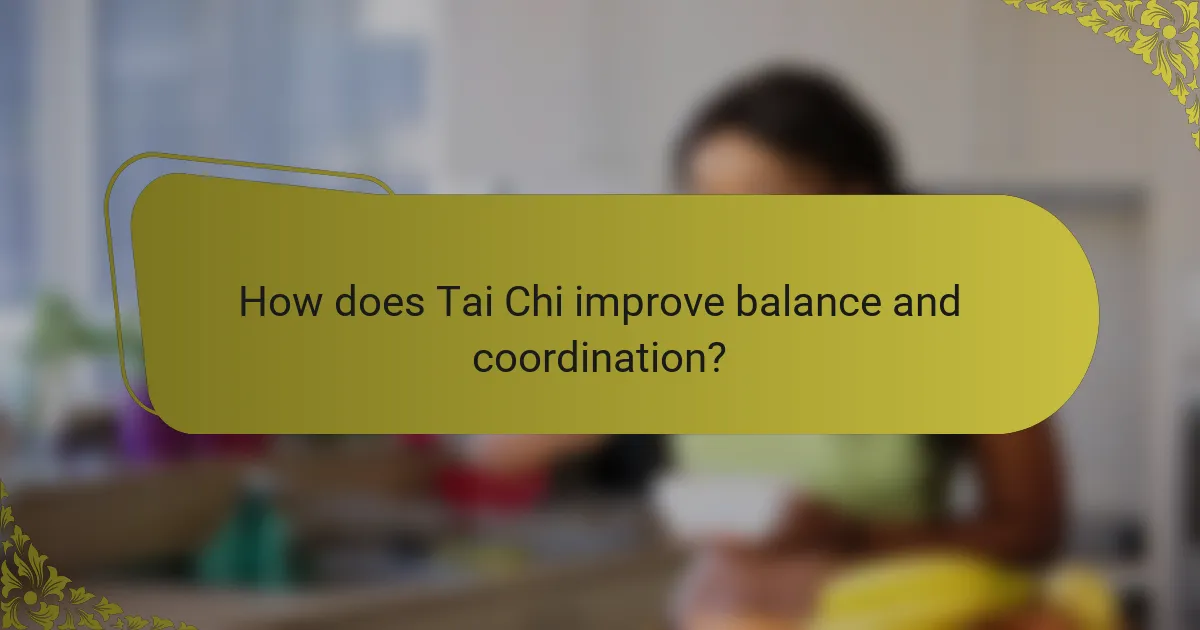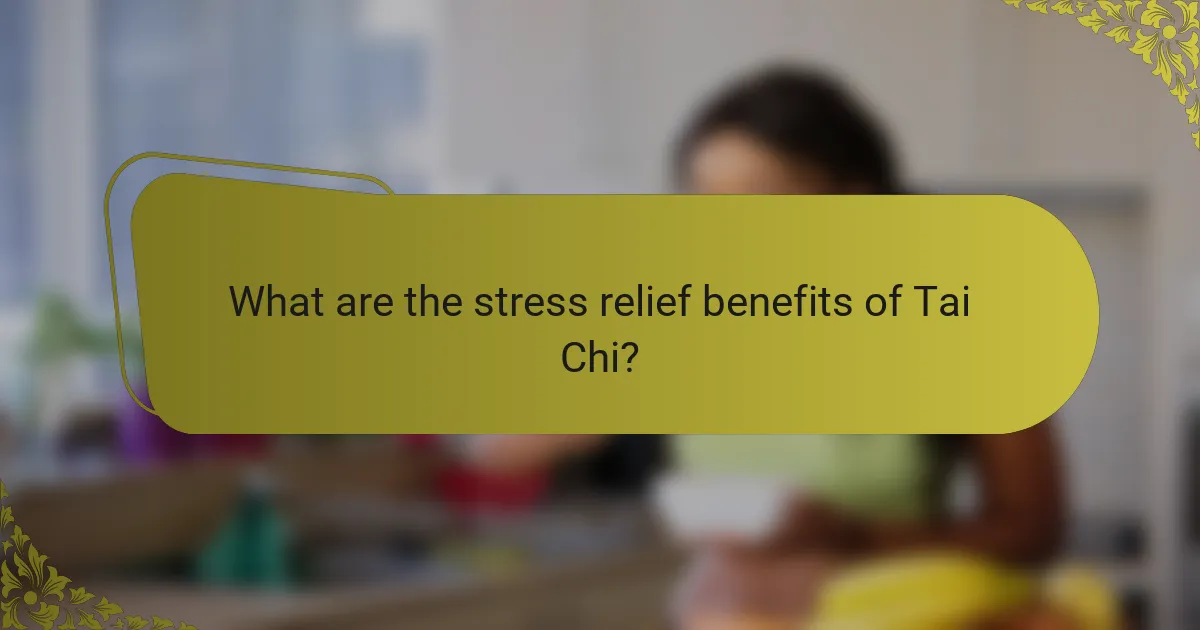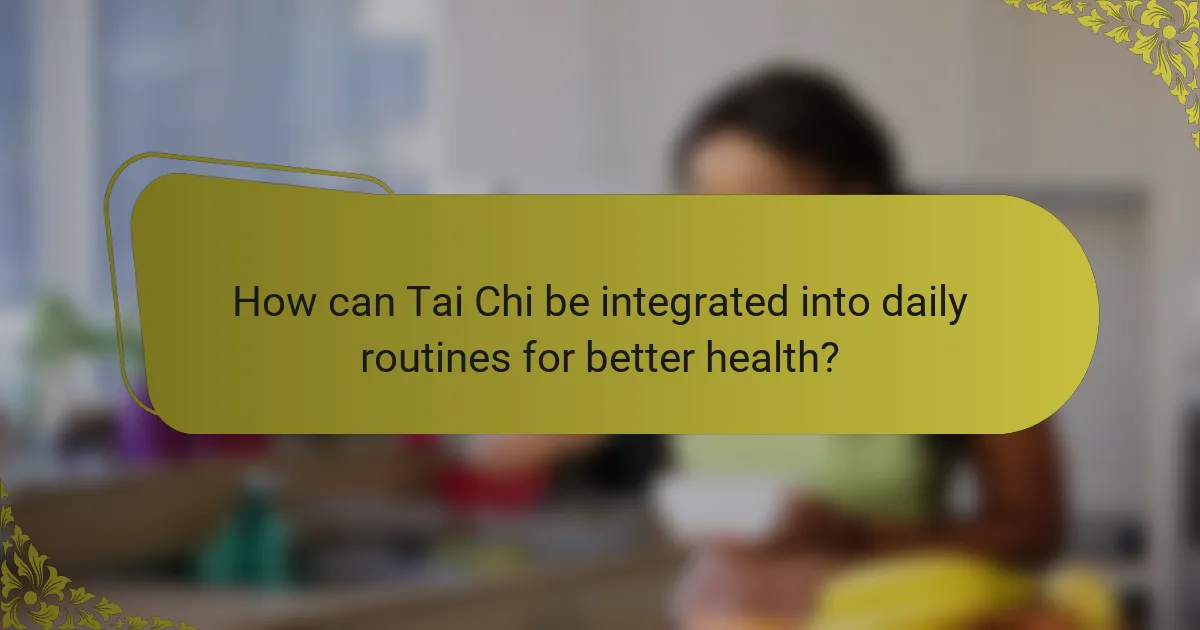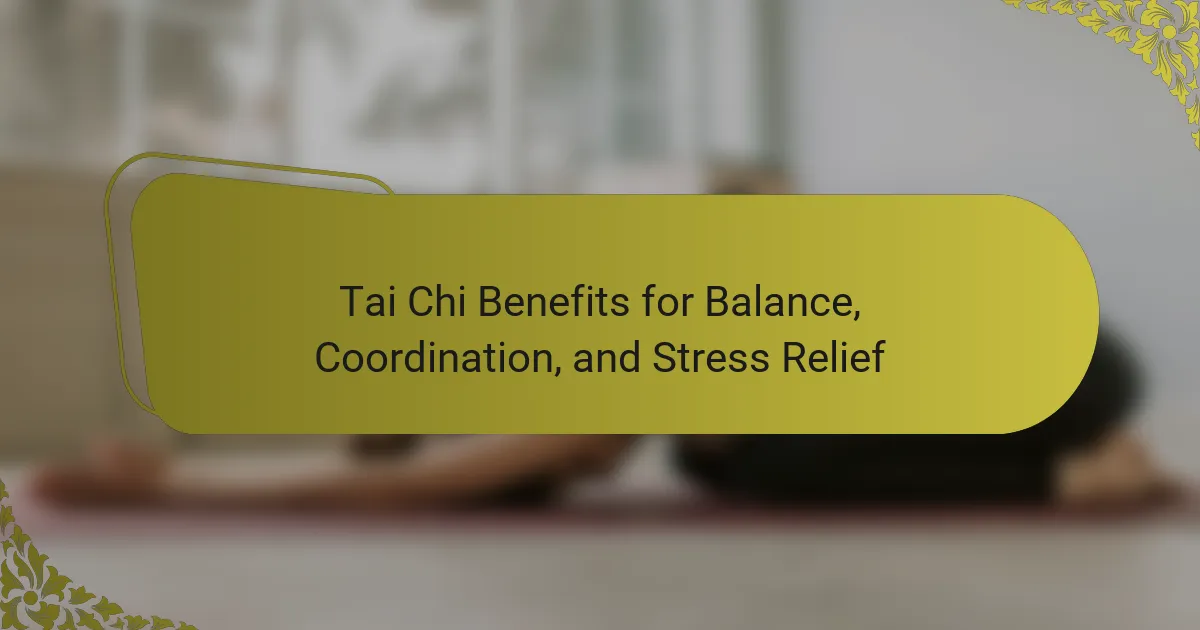Tai Chi enhances balance, coordination, and stress relief through slow, mindful movements. It improves proprioception, reducing fall risk in older adults. The practice lowers cortisol levels, promoting relaxation and mental clarity. Regular engagement fosters a sense of community and enhances emotional well-being.

How does Tai Chi improve balance and coordination?
Tai Chi significantly enhances balance and coordination through its slow, deliberate movements and focus on body awareness. Practicing Tai Chi improves proprioception, the body’s ability to sense its position in space, which is crucial for maintaining balance. Research shows that regular Tai Chi practice can reduce the risk of falls by up to 47% in older adults. Additionally, its emphasis on breathing and mindfulness helps reduce stress, further contributing to overall stability and coordination.
What are the key movements that enhance stability?
Tai Chi enhances stability through slow, controlled movements that improve balance, coordination, and body awareness. Key movements include weight shifting, turning, and arm extensions. These actions strengthen core muscles and promote better posture. Regular practice can significantly reduce fall risk, particularly in older adults.
How does Tai Chi practice affect proprioception?
Tai Chi practice significantly enhances proprioception, improving body awareness and balance. This mind-body exercise encourages slow, deliberate movements that sharpen sensory feedback from muscles and joints. As a result, practitioners develop greater spatial awareness and coordination. Studies show that regular Tai Chi practice can lead to a marked reduction in falls among older adults, highlighting its effectiveness in enhancing stability and proprioceptive skills.
Which age groups benefit most from improved balance?
Older adults and younger children benefit most from improved balance through Tai Chi practice. Tai Chi enhances stability and coordination, reducing fall risk in seniors and aiding motor skills development in children. Research shows that older adults experience significant improvements in balance and strength, while children gain better body awareness and control. These benefits make Tai Chi an effective exercise for diverse age groups, promoting overall well-being.

What are the stress relief benefits of Tai Chi?
Tai Chi provides significant stress relief benefits through its emphasis on slow, mindful movements and deep breathing. Practicing Tai Chi reduces cortisol levels, promoting relaxation and mental clarity.
Research indicates that regular Tai Chi practice can lower anxiety and improve mood, contributing to overall emotional well-being. The focus on balance and coordination fosters a sense of control, further alleviating stress.
Additionally, Tai Chi enhances mindfulness, allowing practitioners to stay present and reduce rumination on stressors. This unique combination of physical and mental engagement makes Tai Chi an effective tool for managing stress.
How does Tai Chi reduce anxiety and promote relaxation?
Tai Chi reduces anxiety and promotes relaxation through slow, mindful movements and deep breathing. This practice enhances the body’s ability to manage stress by lowering cortisol levels and improving overall mental well-being. Research indicates that regular Tai Chi practice can lead to significant reductions in anxiety symptoms and increased feelings of calm. The unique attribute of Tai Chi lies in its integration of physical movement with meditative focus, creating a holistic approach to stress relief. As a result, participants often experience improved balance and coordination alongside mental clarity.
What role does breathing play in stress management during Tai Chi?
Breathing plays a crucial role in stress management during Tai Chi by promoting relaxation and mindfulness. Deep, controlled breathing enhances oxygen flow, reduces heart rate, and calms the nervous system. This process enables practitioners to focus on their movements and cultivate a sense of inner peace. Research shows that mindful breathing can lower cortisol levels, further aiding in stress reduction. Integrating breath awareness into Tai Chi practice fosters a holistic approach to well-being, enhancing the overall benefits of balance and coordination.
Which studies support Tai Chi as an effective stress relief method?
Research supports Tai Chi as an effective stress relief method through various studies. One notable study published in the Journal of Clinical Psychology found that participants practicing Tai Chi reported significant reductions in stress and anxiety levels. Another research published in the Journal of Alternative and Complementary Medicine highlighted that regular Tai Chi practice enhances emotional well-being and decreases perceived stress. Furthermore, a meta-analysis in the journal Health Psychology Review indicated that Tai Chi improves overall mental health, contributing to lower stress responses. These findings collectively underscore Tai Chi’s role in promoting relaxation and reducing stress.

How can Tai Chi be integrated into daily routines for better health?
Integrating Tai Chi into daily routines enhances balance, coordination, and stress relief. Start by dedicating 10-15 minutes each morning for practice. This consistency builds a strong foundation for mental and physical health.
Incorporate Tai Chi into breaks during work or study sessions. A few minutes of focused movement can alleviate stress and improve concentration. Evening sessions can promote relaxation and better sleep quality.
Joining a community class or following online tutorials can provide structure and motivation. Engaging with others enhances accountability and enriches the experience.
Ultimately, regular practice of Tai Chi cultivates a mindful approach to daily activities, fostering overall well-being.
What are the recommended durations and frequencies for practice?
For optimal benefits, practice Tai Chi for at least 20 to 30 minutes, 2 to 3 times per week. Consistent practice enhances balance, coordination, and stress relief. Research indicates that longer sessions, up to an hour, can further deepen these effects. Regular engagement leads to improved physical and mental well-being.
How can beginners start practicing Tai Chi at home?
Beginners can start practicing Tai Chi at home by following simple steps. First, find a quiet space with enough room to move freely. Next, watch instructional videos or use online resources to learn basic forms. Consistency is key; practice for at least 15 minutes daily to improve balance and coordination. Focus on slow, controlled movements to enhance stress relief. As you progress, consider joining a local class or online community for support and guidance.
Which community resources are available for Tai Chi enthusiasts?
Tai Chi enthusiasts can access various community resources, including local classes, online tutorials, and support groups. These resources enhance balance, coordination, and stress relief through structured practice. Many community centers offer classes tailored to different skill levels. Online platforms provide instructional videos and forums for discussion. Additionally, local Tai Chi associations often organize events and workshops to foster connections among practitioners.

What unique attributes make Tai Chi effective for older adults?
Tai Chi is effective for older adults due to its focus on balance, coordination, and stress relief. Its slow, deliberate movements enhance stability, reducing fall risk. The practice promotes mindfulness, which alleviates stress and anxiety. Additionally, Tai Chi improves flexibility and muscle strength, contributing to overall physical health. Unique attributes include its adaptability to various fitness levels and its low-impact nature, making it accessible for seniors. Regular practice can lead to improved mental clarity and emotional well-being, further enhancing quality of life.
How does Tai Chi address age-related balance issues?
Tai Chi effectively addresses age-related balance issues by enhancing stability and coordination through slow, controlled movements. Research shows that regular practice improves proprioception, reducing fall risk among older adults. The focus on mindfulness during Tai Chi also promotes mental clarity and stress relief, contributing to overall well-being. Additionally, Tai Chi strengthens lower body muscles, which is crucial for maintaining balance as one ages.
What adaptations exist for those with physical limitations?
Tai Chi offers various adaptations for individuals with physical limitations, enhancing balance, coordination, and stress relief. Modifications include seated Tai Chi, using chairs for support, and slow, gentle movements. These adaptations accommodate different mobility levels, allowing participation without strain. Additionally, instructors can tailor routines to individual needs, ensuring safety and effectiveness. Research shows that these adaptations can improve overall well-being, making Tai Chi accessible and beneficial for everyone.

Which rare benefits of Tai Chi are often overlooked?
Tai Chi offers unique benefits for balance, coordination, and stress relief that are often overlooked. One rare benefit is enhanced proprioception, which improves body awareness and spatial orientation. This can lead to better movement control and reduced fall risk. Another overlooked aspect is its potential to enhance cognitive function through mindful movement, positively impacting memory and attention. Additionally, Tai Chi fosters a sense of community, which can enhance emotional well-being and reduce feelings of isolation. These benefits contribute to a holistic approach to health that goes beyond physical fitness.
How can Tai Chi enhance cognitive function?
Tai Chi enhances cognitive function by improving focus, memory, and mental clarity. The practice combines slow, deliberate movements with deep breathing, promoting relaxation and reducing stress. Research indicates that regular Tai Chi practice can lead to better executive function and improved cognitive flexibility. Additionally, it fosters mindfulness, which is linked to enhanced cognitive performance.
What impact does Tai Chi have on chronic pain management?
Tai Chi can significantly reduce chronic pain by enhancing physical function and promoting relaxation. Studies indicate that regular practice improves balance and coordination, which may alleviate discomfort. Additionally, Tai Chi fosters mental well-being, reducing stress and anxiety levels associated with chronic pain. The gentle movements stimulate circulation, contributing to pain relief and improved mobility. This holistic approach makes Tai Chi a valuable tool in chronic pain management.

What best practices should practitioners follow for optimal results?
Practitioners should follow these best practices for optimal results in Tai Chi: focus on proper posture, engage in consistent practice, and integrate breathing techniques.
1. Maintain correct alignment to enhance balance and coordination.
2. Practice regularly, aiming for at least three sessions per week to build muscle memory.
3. Incorporate deep breathing to promote relaxation and reduce stress.
4. Start with basic forms before progressing to more complex movements.
5. Seek guidance from qualified instructors to ensure correct technique and prevent injury.
What common mistakes should beginners avoid in Tai Chi?
Beginners should avoid rushing through movements, neglecting proper posture, and skipping warm-ups in Tai Chi. These mistakes can hinder balance, coordination, and stress relief benefits. Focus on slow, deliberate practice to enhance overall effectiveness. Additionally, disregarding breathing techniques can limit stress relief outcomes. Consistent practice with attention to detail will improve performance and enjoyment.
How can one track progress in balance and stress relief through Tai Chi?
Tracking progress in balance and stress relief through Tai Chi involves regular self-assessment and mindful observation. Participants can monitor improvements by noting changes in stability during practice and reduced stress levels in daily life.
Engaging in consistent Tai Chi sessions enhances proprioception, which is the body’s ability to sense its position in space. This improvement can be measured through balance tests, such as standing on one leg for extended periods. Additionally, participants can utilize stress-relief metrics, such as heart rate variability or subjective stress scales, to quantify their progress.
Setting specific goals related to balance and stress relief can further aid in tracking. For instance, aiming to perform a particular Tai Chi form without losing balance or noticing a decrease in anxiety levels after practice can provide clear indicators of improvement.
Regularly journaling experiences and feelings after each session also offers valuable insights into personal progress over time. This reflective practice can highlight the benefits of Tai Chi for both physical balance and emotional well-being.
